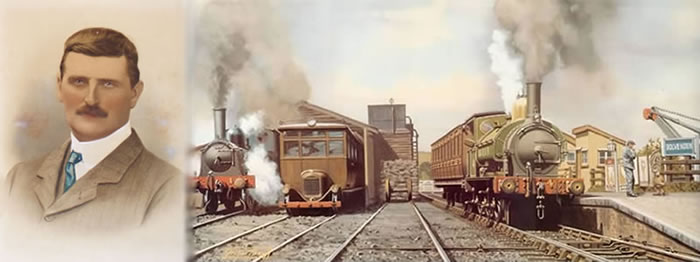The Colonel Stephens Railway Museum
Recording the Career of Holman Fred Stephens, Light Railway Promoter,
Engineer and Manager, His Family, His Railways and His Successors.

An introduction to the Museum
The Museum is devoted to Colonel Holman F Stephens (1868-1931), Promoter and Manager of Rural Light Railways and the builder and manager of the Kent & East Sussex Railway.
The concept of light railways was a way of bringing cheap transport to rural areas. With the passing of a Light Railways Act in 1896 enthusiasm for such lines was at an all-time high; but it was still necessary to turn a vision into practical success. Holman Stephens, with his engineering and management skills, became the leading independent engineering dynamic behind the light railway movement. In his lifetime he built or managed some 16 light railways, ranging from the diminutive Rye & Camber Tramway on the Sussex coast, to the Shropshire and Montgomeryshire Railway in the Welsh Marches and was associated with advanced plans for at least another 30 that remained un-built.
The enthusiasm for rural light railways did not last very long. They had arrived too late and costs could not be kept low enough. By 1914 the concept was effectively dead but Stephens did not give up: he persisted with several schemes and built them when he could.
Stephens had successfully lobbied the government to enable light railways to retain their independence from the 'Grouping' of railways in 1923 under the Railways Act 1921. He strongly held the view that such railways should have separate management or become lost in the oversight of the major railways. A handful of these independents took this option, the majority under Stephens’ leadership.
The rise of the motor lorry and bus in the 1920s stripped the rural branch railway and particularly the rural light railway of much of its purpose. Goods traffic, particularly the high-value parcels and 'smalls' traffic, transferred to the roads. Passenger traffic had never been great, for country people did not travel much except to market, and now when they did it was by the cheaper and more convenient motor bus. The remaining independents were by the late 1920s and early 1930s in financial difficulty.
This changed the direction of Stephens’ business and increasingly he became less a promoter and builder and more a manager. His Salford Terrace, Tonbridge office turned from design and construction to centralised accounting and administration, engineering maintenance and oversight. Despite innovative use of limited capital for projects like the use of lightweight rail motors, independent railways fell into decline and bankruptcy. Ultimately the price of independence was poverty, often worse in its effect than neglectful centralised management. Even independence for railways was lost as they became part of Government and the rural railway disappeared in the 1950s and 1960s.
Stephens was a man of his time and, like the Railway itself, was perhaps born too late. We should however admire him for his energy and achievement in the circumstances of his heyday.
Return to Museum Menu Return to Main Menu Book Online and Save

